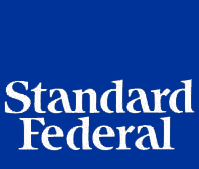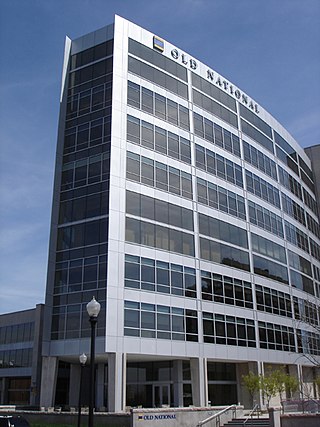
The Federal Deposit Insurance Corporation (FDIC) is a United States government corporation supplying deposit insurance to depositors in American commercial banks and savings banks. The FDIC was created by the Banking Act of 1933, enacted during the Great Depression to restore trust in the American banking system. More than one-third of banks failed in the years before the FDIC's creation, and bank runs were common. The insurance limit was initially US$2,500 per ownership category, and this has been increased several times over the years. Since the enactment of the Dodd–Frank Wall Street Reform and Consumer Protection Act in 2010, the FDIC insures deposits in member banks up to $250,000 per ownership category. FDIC insurance is backed by the full faith and credit of the government of the United States, and according to the FDIC, "since its start in 1933 no depositor has ever lost a penny of FDIC-insured funds".
Washington Mutual, Inc. was an American savings bank holding company based in Seattle. It was the parent company of WaMu Bank, which was the largest savings and loan association in the United States until its collapse in 2008.

The savings and loan crisis of the 1980s and 1990s was the failure of 32% of savings and loan associations (S&Ls) in the United States from 1986 to 1995. An S&L or "thrift" is a financial institution that accepts savings deposits and makes mortgage, car and other personal loans to individual members.

Carl Ray Pohlad was an American financier from Minnesota. Pohlad is best known as the owner of the Minnesota Twins baseball franchise from 1984 until his death in 2009.

Standard Federal Bank was a Troy, Michigan-based bank serving Michigan and Northern Indiana in the United States which was acquired by Bank of America on 5 May 2008.

Old National Bank is an American regional bank with nearly 200 retail branches operated by Old National Bancorp and based in Chicago and Evansville, Indiana. With assets at $48.5 billion and 250 banking centers, Old National Bancorp is the largest financial services bank holding company headquartered in Indiana and one of the top 30 banking companies in the U.S. Its primary banking footprint is in Illinois, Indiana, Kentucky, Michigan, Minnesota, and Wisconsin.
Great Western Bank was a large retail bank that operated primarily in the Western United States. Great Western's headquarters were in Chatsworth, California. At one time, Great Western was one of the largest savings and loan in the United States, second only to Home Savings of America. The bank was acquired by Washington Mutual in 1997 for $6.8 billion.
H.F. Ahmanson & Co. was a California holding company named after Howard F. Ahmanson Sr. It was best known as the parent of Home Savings of America, once one of the largest savings and loan associations in the United States.
Marquette Bank Minneapolis, formerly named the Marquette National Bank, was a bank in Minneapolis, Minnesota. It was party to Marquette National Bank of Minneapolis v. First of Omaha Service Corp., an important decision by the Supreme Court of the United States which regulated the banking industry.
IndyMac, a contraction of Independent National Mortgage Corporation, was an American bank based in California that failed in 2008 and was seized by the United States Federal Deposit Insurance Corporation (FDIC).
Firstar Corporation was a Milwaukee, Wisconsin-based regional bank holding company that existed from 1853 to 2001. In 2001, Firstar acquired U.S. Bancorp and assumed its name, moving its headquarters to Minneapolis.
Western Savings and Loan was an American financial institution founded by the Driggs family.

The Lincoln Savings and Loan Association of Irvine, California, was the financial institution at the heart of the Keating Five scandal during the 1980s savings and loan crisis.
The government interventions during the subprime mortgage crisis were a response to the 2007–2009 subprime mortgage crisis and resulted in a variety of government bailouts that were implemented to stabilize the financial system during late 2007 and early 2008.
Capitol Federal Savings Bank (CapFed) is a federally chartered and insured savings bank founded in 1893 and headquartered in Topeka, Kansas. Capitol Federal has 51 locations serving both the Kansas and Missouri sides of the Kansas City metropolitan area with personal and business financial services. It is owned by holding company Capitol Federal Financial Inc. for trading on the Nasdaq.
Guaranty Bank was a major bank based in Austin, which collapsed in 2009. It was formed in 1988 as part of Temple-Inland and in 2007 became a standalone company. At the time of its collapse, Guaranty was the second largest bank in Texas, with 162 branches across Texas and California, and had $13 billion in assets and held $12 billion in deposits. Major shareholders included billionaire investor Carl Icahn and hotel tycoon Robert Rowling, who jointly invested $600 million in the bank in 2008.
Bank United Corporation, headquartered in Houston, Texas, was a broad-based financial services provider and the largest publicly traded depository institution headquartered in Texas before its merger with Washington Mutual in 2001. Bank United Corp. conducted its business through its wholly owned subsidiary, Bank United, a federally chartered savings bank. The company operated a 155-branch community banking network in Texas, including 77 in the Dallas/Fort Worth Metroplex, 66 in the greater Houston area, five in Midland, four in Austin, and three in San Antonio; operated 19 SBA lending offices in 14 states; was a national middle market commercial bank with 23 regional offices in 16 states; originated mortgage loans through 11 wholesale offices in 10 states; operated a national mortgage servicing business serving approximately 324,000 customers, and managed an investment portfolio. As of June 30, 2000, Bank United Corp. had assets of $18.2 billion, deposits of $8.8 billion, and stockholder's equity of $823 million.

First Bank System was a Minneapolis, Minnesota-based regional bank holding company that operated from 1864 to 1997. What was once First Bank forms the core of today's U.S. Bancorp; First Bank merged with the old U.S. Bancorp in 1997 and took the U.S. Bancorp name.
CenTrust Bank, A State Savings Bank was an American savings and loan association based in Miami, Florida that failed in 1990. Its failure in 1990 was one of the largest and costliest failures of the savings and loan crisis.
American Savings and Loan Association was an American savings and loan based in Stockton, California. In 1988 it was the largest thrift failure and the federal government's costliest resolution during the savings and loan crisis at an estimated cost of $5.4 billion.





